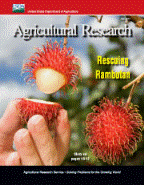United States Department of Agriculture: Agricultural Research Service, Lincoln, Nebraska

Agricultural Research Magazine
Date of this Version
4-2013
Document Type
Article
Citation
Agricultural Research April 2013.
Abstract
The U.S. Department of Agriculture’s Natural Resources Conservation Service (NRCS) is looking for ways to upgrade the Phosphorus Index, a simple management tool developed during the 1990s to gauge the risk of phosphorus losses from agricultural fields. In developing a national nutrient-management policy, NRCS allowed states to modify the original index—a matrix of source and transport factors that contribute to phosphorus loss— with inputs to account for local variations in soils, climate, management, and water quality goals.
But this resulted in widely different state-by-state phosphorus indices that often didn’t agree with each other on how to manage phosphorus. “We’d put in the same numbers and get different results, depending on the state,” says Agricultural Research Service soil scientist Peter Vadas, who works at the U.S. Dairy Forage Research Center in Madison, Wisconsin. Additionally, many of these indices were not tested against monitoring data to show that they gave reliable results, or they didn’t quantify phosphorus loss—such as losses in pounds per acre—which made them difficult to test against field data.
So Vadas worked with colleagues to develop the Annual Phosphorus Loss Estimator (APLE), a user-friendly spreadsheet program that predicts field-scale phosphorus loss in runoff for a whole year. His ARS partners included hydrologist Carl Bolster, in Bowling Green, Kentucky; soil scientist Philip Moore, in Fayetteville, Arkansas; and agricultural engineer Michael White, in Temple, Texas. University of Wisconsin researcher Laura Good and Purdue University researcher Brad Joern also partnered on the project.
Included in
Agriculture Commons, Animal Sciences Commons, Food Science Commons, Plant Sciences Commons

